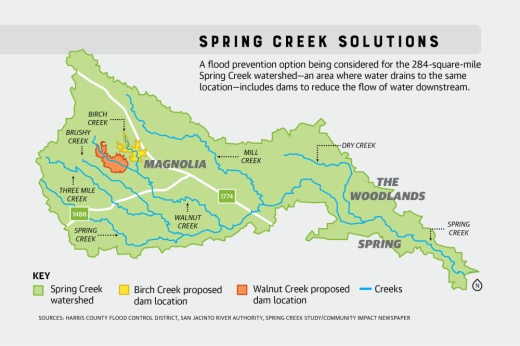Editor's note: This story was updated to correct the definition of the term "inundation." In this project, it refers to an upstream area, rather than a downstream area as was originally noted.
The San Jacinto River Authority ran into two challenges while conducting its Spring Creek Flood Control Dam Feasibility Study over the past year. The river authority, which manages water resources in the San Jacinto basin, shared information about those concerns and the future funding sources for the study at a public information meeting May 2 at The Woodlands Township.
"The Master Drainage Plan only took a very high-level look at the various projects recommended," SJRA Division Manager Matt Barrett said at the meeting. "So the goal of this study was to look deeper down into the project and really determine how feasible and cost-effective these dams are."
According to previous Community Impact coverage, the proposed project includes considering building two dams, one at Birch Creek and one at Walnut Creek, to reduce flooding along Spring Creek.
At the May 2 meeting, Barrett said the feasibility study ran into two challenges, including a lower benefit-cost ratio than projected as well as planned development activity on each proposed dam site.
According to Federal Emergency Management Agency, a project is considered cost-effective when the benefit-cost ratio is 1.0 or higher. Barrett said because a lower benefit-cost ratio was calculated, the two dams were reduced in size by height, spillway and inundation.
According to Barrett, an inundation area in this case is the area estimated to be covered upstream of the dams during storm events, and a spillway prevents overtopping of dams.
In the revised calculations, the height of the Birch Creek dam will reduced by 10 feet, the spillway will be reduced by 5 feet, and the inundation area will be reduced by almost 300 acres from original estimates. Walnut Creek's height will be reduced by 12 feet, the spillway by 6 feet, and the inundation area by 500 acres, he said. These changes, along with the use of social benefits in the FEMA Benefit Cost Toolkit, will raise the BCR for Birch Creek from 0.45 to 2.03 and Walnut Creek from 0.29 to 1.88, according to Barrett.
"By reducing the size of the dams, we saved costs there," Barrett said. "We also reduced the land estimated amount of land that would be inundated, which means less land that would need to be acquired."
Barrett said the more difficult problem to solve will include working with developers currently building on dam sites. A proposed residential development is slated to build on 300 acres within the inundation area on Birch Creek. At Walnut Creek, a solar farm has already begun construction on 100 acres of panels in the inundation area.
"We so hope we can work with [the developers] to move the dam or reduce the size of the dam, to try and coexist there," Barrett said.
SJRA also discussed cost estimates and funding options. At the first public input meeting April 7, initial costs were expected to reach $80 million-$132 million each at current rates. According to a presentation May 2, the total cost of a Birch Creek dam decreased from $97 million to $86 million. Walnut Creek decreased from $148 million to $93 million.
Barrett said the combination of both dams will end up with a lower BCR than constructing the dams individually. The total estimated cost for both is $179 million.
SJRA received a $500,000 grant from the Texas Water Development Board for the feasibility study and an additional $500,000 match from a combination of the city of Humble, Harris County Flood Control District and five Woodlands municipal utility districts, according to Barrett. SJRA will also provide project and grant management.
"This is a great example of multiple entities across the region working together to mitigate flooding issues," he said. "Now, we really want to hear from the public and other stakeholders to determine the level of support behind these dams and studies and then potentially look into long-term planning for construction."
Barrett said SJRA will hold at least one more final public meeting to determine interest before coordinating with developers and determining the feasibility of the project.





